Does Ambient Secondary Conversion or the Prolonged Fast Conversion in Combustion Plumes Cause Severe PM2.5 Air Pollution in China?
Abstract
:1. Introduction
2. Materials and Methods
2.1. Data Sources
2.2. Scenario Analysis
2.3. Meteorological and Air Quality Model
3. Results
3.1. Evidence for Negligible FSPM during Severe PM2.5 Air Pollution in Inland Atmospheres
3.2. Evidence for Negligible FSPM during Severe PM2.5 Air Pollution in Coastal Atmospheres
4. Discussion
4.1. Impractical Conversion Rate of SO2 to SO42− Absence of Non-Precipitation Cloud during the Events
4.2. Hypothesis for In-Fresh-Stack-Plume Non-Precipitation-Cloud Processing of Aerosols
5. Implications
Supplementary Materials
Author Contributions
Funding
Institutional Review Board Statement
Informed Consent Statement
Data Availability Statement
Conflicts of Interest
References
- An, Z.; Huang, R.J.; Zhang, R.; Tie, X.; Li, G.; Cao, J.; Zhou, W.; Shi, Z.; Han, Y.; Gu, Z.; et al. Severe haze in northern China: A synergy of anthropogenic emissions and atmospheric processes. Proc. Natl. Acad. Sci. USA 2019, 116, 8657–8666. [Google Scholar] [CrossRef] [PubMed] [Green Version]
- Cai, S.; Wang, Y.; Zhao, B.; Wang, S.; Chang, X.; Hao, J. The impact of the “Air Pollution Prevention and Control Action Plan” on PM2.5 concentrations in Jing-Jin-Ji region during 2012–2020. Sci. Total Environ. 2017, 580, 197–209. [Google Scholar] [CrossRef] [PubMed]
- Chan, C.K.; Yao, X. Air pollution in mega cities in China. Atmos. Environ. 2008, 42, 1–42. [Google Scholar] [CrossRef]
- Chang, W.; Zhan, J.; Zhang, Y.; Li, Z.; Xing, J.; Li, J. Emission-driven changes in anthropogenic aerosol concentrations in China during 1970–2010 and its implications for PM2.5 control policy. Atmos. Res. 2018, 212, 106–119. [Google Scholar] [CrossRef]
- Chen, Z.; Chen, D.; Wen, W.; Zhuang, Y.; Kwan, M.-P.; Chen, B.; Zhao, B.; Yang, L.; Gao, B.; Li, R.; et al. Evaluating the “2 + 26” regional strategy for air quality improvement during two air pollution alerts in Beijing: Variations in PM2.5 concentrations, source apportionment, and the relative contribution of local emission and regional transport. Atmos. Chem. Phys. 2019, 19, 6879–6891. [Google Scholar] [CrossRef] [Green Version]
- Elser, M.; Huang, R.-J.; Wolf, R.; Slowik, J.G.; Wang, Q.; Canonaco, F.; Li, G.; Bozzetti, C.; Daellenbach, K.R.; Huang, Y.; et al. New insights into PM2.5 chemical composition and sources in two major cities in China during extreme haze events using aerosol mass spectrometry. Atmos. Chem. Phys. 2016, 16, 3207–3225. [Google Scholar] [CrossRef] [Green Version]
- Ji, D.; Li, L.; Wang, Y.; Zhang, J.; Cheng, M.; Sun, Y.; Liu, Z.; Wang, L.; Tang, G.; Hu, B.; et al. The heaviest particulate air-pollution episodes occurred in northern China in January, 2013: Insights gained from observation. Atmos. Environ. 2014, 92, 546–556. [Google Scholar] [CrossRef]
- Lachatre, M.; Fortems-Cheiney, A.; Foret, G.; Siour, G.; Dufour, G.; Clarisse, L.; Clerbaux, C.; Coheur, P.-F.; Van Damme, M.; Beekmann, M. The unintended consequence of SO2 and NO2 regulations over China: Increase of ammonia levels and impact on PM2.5 concentrations. Atmos. Chem. Phys. 2019, 19, 6701–6716. [Google Scholar] [CrossRef] [Green Version]
- Si, Y.; Yu, C.; Zhang, L.; Zhu, W.; Cai, K.; Cheng, L.; Chen, L.; Li, S. Assessment of satellite-estimated near-surface sulfate and nitrate concentrations and their precursor emissions over China from 2006 to 2014. Sci. Total Environ. 2019, 669, 362–376. [Google Scholar] [CrossRef]
- Sun, Y.L.; Wang, Z.F.; Du, W.; Zhang, Q.; Wang, Q.Q.; Fu, P.Q.; Pan, X.L.; Li, J.; Jayne, J.; Worsnop, D.R. Long-term real-time measurements of aerosol particle composition in Beijing, China: Seasonal variations, meteorological effects, and source analysis. Atmos. Chem. Phys. 2015, 15, 10149–10165. [Google Scholar] [CrossRef] [Green Version]
- Wang, Y.; Zhang, Q.Q.; He, K.; Zhang, Q.; Chai, L. Sulfate-nitrate-ammonium aerosols over China: Response to 2000–2015 emission changes of sulfur dioxide, nitrogen oxides, and ammonia. Atmos. Chem. Phys. 2013, 13, 2635–2652. [Google Scholar] [CrossRef] [Green Version]
- Zhao, X.J.; Zhao, P.S.; Xu, J.; Meng, W.; Pu, W.W.; Dong, F.; He, D.; Shi, Q.F. Analysis of a winter regional haze event and its formation mechanism in the North China Plain. Atmos. Chem. Phys. 2013, 13, 5685–5696. [Google Scholar] [CrossRef] [Green Version]
- Zheng, B.; Zhang, Q.; Zhang, Y.; He, K.B.; Wang, K.; Zheng, G.J.; Duan, F.K.; Ma, Y.L.; Kimoto, T. Heterogeneous chemistry: A mechanism missing in current models to explain secondary inorganic aerosol formation during the January 2013 haze episode in North China. Atmos. Chem. Phys. 2015, 15, 2031–2049. [Google Scholar] [CrossRef] [Green Version]
- Li, M.; Wang, T.; Xie, M.; Li, S.; Zhuang, B.; Huang, X.; Chen, P.; Zhao, M.; Liu, J. Formation and Evolution Mechanisms for Two Extreme Haze Episodes in the Yangtze River Delta Region of China During Winter 2016. J. Geophys. Res. Atmos. 2019, 124, 3607–3623. [Google Scholar] [CrossRef]
- Yang, Y.; Liu, X.; Qu, Y.; Wang, J.; An, J.; Zhang, Y.; Zhang, F. Formation mechanism of continuous extreme haze episodes in the megacity Beijing, China, in January 2013. Atmos. Res. 2015, 155, 192–203. [Google Scholar] [CrossRef]
- Chang, Y.; Huang, R.J.; Ge, X.; Huang, X.; Hu, J.; Duan, Y.; Zou, Z.; Liu, X.; Lehmann, M.F. Puzzling haze events in China during the coronavirus (COVID-19) shutdown. Geophys Res. Lett. 2020, 47, e2020GL088533. [Google Scholar] [CrossRef] [PubMed]
- Wang, J.; Li, J.; Ye, J.; Zhao, J.; Wu, Y.; Hu, J.; Liu, D.; Nie, D.; Shen, F.; Huang, X.; et al. Fast sulfate formation from oxidation of SO2 by NO2 and HONO observed in Beijing haze. Nat. Commun. 2020, 11, 2844. [Google Scholar] [CrossRef]
- Cheng, Y.; Zheng, G.; Wei, C.; Mu, Q.; Zheng, B.; Wang, Z.; Gao, M.; Zhang, Q.; He, K.; Carmichael, G.; et al. Reactive nitrogen chemistry in aerosol water as a source of sulfate during haze events in China. Sci. Adv. 2016, 2, e1601530. [Google Scholar] [CrossRef] [Green Version]
- Guo, S.; Hu, M.; Zamora, M.L.; Peng, J.; Shang, D.; Zheng, J.; Du, Z.; Wu, Z.; Shao, M.; Zeng, L.; et al. Elucidating severe urban haze formation in China. Proc. Natl. Acad. Sci. USA 2014, 111, 17373–17378. [Google Scholar] [CrossRef] [Green Version]
- Huang, R.J.; Zhang, Y.; Bozzetti, C.; Ho, K.F.; Cao, J.J.; Han, Y.; Daellenbach, K.R.; Slowik, J.G.; Platt, S.M.; Canonaco, F.; et al. High secondary aerosol contribution to particulate pollution during haze events in China. Nature 2014, 514, 218–222. [Google Scholar] [CrossRef] [Green Version]
- Moch, J.M.; Dovrou, E.; Mickley, L.J.; Keutsch, F.N.; Cheng, Y.; Jacob, D.J.; Jiang, J.; Li, M.; Munger, J.W.; Qiao, X.; et al. Contribution of hydroxymethane sulfonate to ambient particulate matter: A potential explanation for high particulate sulfur during severe winter haze in Beijing. Geophys. Res. Lett. 2018, 45, 11969–11979. [Google Scholar] [CrossRef] [Green Version]
- Wang, G.; Zhang, R.; Gomez, M.E.; Yang, L.; Levy Zamora, M.; Hu, M.; Lin, Y.; Peng, J.; Guo, S.; Meng, J.; et al. Persistent sulfate formation from London Fog to Chinese haze. Proc. Natl. Acad. Sci. USA 2016, 113, 13630–13635. [Google Scholar] [CrossRef] [PubMed] [Green Version]
- Guo, T.; Guo, Z.; Wang, J.; Feng, J.; Gao, H.; Yao, X. Tracer-based investigation of organic aerosols in marine atmospheres from marginal seas of China to the northwest Pacific Ocean. Atmos. Chem. Phys. 2020, 20, 5055–5070. [Google Scholar] [CrossRef]
- Man, H.; Zhu, Y.; Ji, F.; Yao, X.; Lau, N.T.; Li, Y.; Lee, B.P.; Chan, C.K. Comparison of daytime and nighttime new particle growth at the HKUST supersite in Hong Kong. Environ. Sci. Technol. 2015, 49, 7170–7178. [Google Scholar] [CrossRef] [PubMed]
- Shen, Y.; Wang, J.; Gao, Y.; Chan, C.K.; Zhu, Y.; Gao, H.; Petaja, T.; Yao, X. Sources and formation of nucleation mode particles in remote tropical marine atmospheres over the South China Sea and the Northwest Pacific Ocean. Sci. Total Environ. 2020, 735, 139302. [Google Scholar] [CrossRef] [PubMed]
- Yao, X.; Lau, N.T.; Fang, M.; Chan, C.K. Real-Time observation of the Transformation of Ultrafine Atmospheric Particle Modes. Aerosol Sci. Technol. 2005, 39, 831–841. [Google Scholar] [CrossRef]
- Feng, L.; Yang, T.; Wang, D.; Wang, Z.; Pan, Y.; Matsui, I.; Chen, Y.; Xin, J.; Huang, H. Identify the contribution of elevated industrial plume to ground air quality by optical and machine learning methods. Environ. Res. Commun. 2020, 2, 021005. [Google Scholar] [CrossRef]
- Li, Z.; Jiang, J.; Ma, Z.; Fajardo, O.A.; Deng, J.; Duan, L. Influence of flue gas desulfurization (FGD) installations on emission characteristics of PM2.5 from coal-fired power plants equipped with selective catalytic reduction (SCR). Environ. Pollut. 2017, 230, 655–662. [Google Scholar] [CrossRef]
- Wei, Y.; Chen, H.; Sun, H.; Zhang, F.; Shang, X.; Yao, L.; Zheng, H.; Li, Q.; Chen, J. Nocturnal PM2.5 explosive growth dominates severe haze in the rural North China Plain. Atmos. Res. 2020, 242, 105020. [Google Scholar] [CrossRef]
- Lonsdale, C.R.; Stevens, R.G.; Brock, C.A.; Makar, P.A.; Knipping, E.M.; Pierce, J.R. The effect of coal-fired power-plant SO2 and NOx control technologies on aerosol nucleation in the source plumes. Atmos. Chem. Phys. 2012, 12, 11519–11531. [Google Scholar] [CrossRef] [Green Version]
- Lee, S.W.; Herage, T.; Dureau, R.; Young, B. Measurement of PM2.5 and ultra-fine particulate emissions from coal-fired utility boilers. Fuel 2013, 108, 60–66. [Google Scholar] [CrossRef]
- Brock, C.A.; Washenfelder, R.A.; Trainer, M.; Ryerson, T.B.; Wilson, J.C.; Reeves, J.M.; Huey, L.G.; Holloway, J.S.; Parrish, D.D.; Hübler, G.; et al. Particle growth in the plumes of coal-fired power plants. J. Geophys. Res. 2002, 107, D12. [Google Scholar] [CrossRef]
- Marris, H.; Deboudt, K.; Augustin, P.; Flament, P.; Blond, F.; Fiani, E.; Fourmentin, M.; Delbarre, H. Fast changes in chemical composition and size distribution of fine particles during the near-field transport of industrial plumes. Sci. Total. Environ. 2012, 427, 126–138. [Google Scholar] [CrossRef]
- Mylläri, F.; Asmi, E.; Anttila, T.; Saukko, E.; Vakkari, V.; Pirjola, L.; Hillamo, R.; Laurila, T.; Häyrinen, A.; Rautiainen, J.; et al. New particle formation in the fresh flue-gas plume from a coal-fired power plant: Effect of flue-gas cleaning. Atmos. Chem. Phys. 2016, 16, 7485–7496. [Google Scholar] [CrossRef] [Green Version]
- Arya, S.P. Modeling and Parameterization of Near-Source Diffusion in Weak Winds. J. Appl. Meteorol. 1995, 34, 1112. [Google Scholar] [CrossRef]
- Lei, L.; Sun, Y.; Ouyang, B.; Qiu, Y.; Xie, C.; Tang, G.; Zhou, W.; He, Y.; Wang, Q.; Cheng, X.; et al. Vertical distributions of primary and secondary aerosols in urban boundary layer: Insights into sources, chemistry, and interaction with meteorology. Environ. Sci. Technol. 2021, 55, 4542–4552. [Google Scholar] [CrossRef]
- Zhu, Y.; Sabaliauskas, K.; Liu, X.; Meng, H.; Gao, H.; Jeong, C.-H.; Evans, G.J.; Yao, X. Comparative analysis of new particle formation events in less and severely polluted urban atmosphere. Atmos. Environ. 2014, 98, 655–664. [Google Scholar] [CrossRef]
- Teng, X.; Hu, Q.; Zhang, L.; Qi, J.; Shi, J.; Xie, H.; Gao, H.; Yao, X. Identification of major sources of atmospheric NH3 in an urban environment in Northern China during wintertime. Environ. Sci. Technol. 2017, 51, 6839–6848. [Google Scholar] [CrossRef]
- Fernald, F.G. Analysis of atmospheric lidar observations: Some comments. Appl. Opt. 1984, 23, 652–653. [Google Scholar] [CrossRef]
- Liu, X.; Chang, M.; Zhang, J.; Wang, J.; Gao, H.; Gao, Y.; Yao, X. Rethinking the causes of extreme heavy winter PM2.5 pollution events in northern China. Sci. Total Environ. 2021, 794, 148637. [Google Scholar] [CrossRef]
- US-EPA. Guidance on the Use of Models and Other Analyses for demonstrating attainment of Air Quality Goals for Ozone, PM2.5 and Regional Haze; EPA-454/B-07-002; U.S. Environmental Protection Agency: Research Triangle Park, NC, USA, 2007.
- Sun, Y.; Jiang, Q.; Wang, Z.; Fu, P.; Li, J.; Yang, T.; Yin, Y. Investigation of the sources and evolution processes of severe haze pollution in Beijing in January 2013. J. Geophys. Res. Atmos. 2014, 119, 4380–4398. [Google Scholar] [CrossRef]
- Wu, B.; Tian, H.; Hao, Y.; Liu, S.; Liu, X.; Liu, W.; Bai, X.; Liang, W.; Lin, S.; Wu, Y.; et al. Effects of wet flue gas desulfurization and wet electrostatic precipitators on emission characteristics of particulate matter and its ionic compositions from four 300 MW level ultralow coal-fired power plants. Environ. Sci. Technol. 2018, 52, 14015–14026. [Google Scholar] [CrossRef] [PubMed]
- Liu, X.; Van Espen, P.; Adams, F.; Cafmeyer, J.; Maenhaut, W. Biomass burning in Southern Africa: Individual particle characterization of atmospheric aerosols and savanna fire samples. J. Atmos. Chem. 2000, 36, 135–155. [Google Scholar] [CrossRef]
- Wu, B.; Bai, X.; Liu, W.; Lin, S.; Liu, S.; Luo, L.; Guo, Z.; Zhao, S.; Lv, Y.; Zhu, C.; et al. Non-negligible stack emissions of noncriteria air pollutants from coal-fired power plants in China: Condensable particulate matter and sulfur trioxide. Environ. Sci. Technol. 2020, 54, 6540–6550. [Google Scholar] [CrossRef] [PubMed]
- Ding, X.; Li, Q.; Wu, D.; Wang, X.; Li, M.; Wang, T.; Wang, L.; Chen, J. Direct observation of sulfate explosive growth in wet plumes emitted from typical coal-fired stationary sources. Geophys. Res. Lett. 2021, 48, e2020GL092071. [Google Scholar] [CrossRef]
- Dittenhoefer, A.C.; De Pena, R.G. Sulfate aerosol production and growth in coal-operated power plant plumes. J. Geophys. Res. Ocean. 1980, 85, 4499–4506. [Google Scholar] [CrossRef]
- Green, J.R.; Fiddler, M.N.; Holloway, J.S.; Fibiger, D.L.; McDuffie, E.E.; Campuzano-Jost, P.; Schroder, J.C.; Jimenez, J.L.; Weinheimer, A.J.; Aquino, J.; et al. Rates of wintertime atmospheric SO2 oxidation based on aircraft observations during clear-sky conditions over the Eastern United States. J. Geophys. Res. Atmos. 2019, 124, 6630–6649. [Google Scholar] [CrossRef]
- Luria, M.; Imhoff, R.E.; Valente, R.J.; Parkhurst, W.J.; Tanner, R.L. Rates of conversion of sulfur dioxide to sulfate in a scrubbed power plant plume. J. Air Waste Manag. Assoc. 2001, 51, 1408–1413. [Google Scholar] [CrossRef] [Green Version]
- Hoppel, W.A.; Frick, G.M.; Fitzgerald, J.W. Deducing droplet concentration and supersaturation in marine boundary layer clouds from surface aerosol measurements. J. Geophys. Res. Atmospheres 1996, 101, 26553–26565. [Google Scholar] [CrossRef]
- Leng, C.-B.; Roberts, J.E.; Zeng, G.; Zhang, Y.-H.; Liu, Y. Effects of temperature, pH, and ionic strength on the Henry’s law constant of triethylamine. Geophys. Res. Lett. 2015, 42, 3569–3575. [Google Scholar] [CrossRef]
- Seinfeld, J.H.; Pandis, S.N. Atmospheric Chemistry and Physics: From Air Pollution to Global Climate, 3rd. ed.; Wiley: New York, NY, USA, 1997. [Google Scholar]
- Yao, X.; Zhang, L. Chemical processes in sea-salt chloride depletion observed at a Canadian rural coastal site. Atmos. Environ. 2012, 46, 189–194. [Google Scholar] [CrossRef]
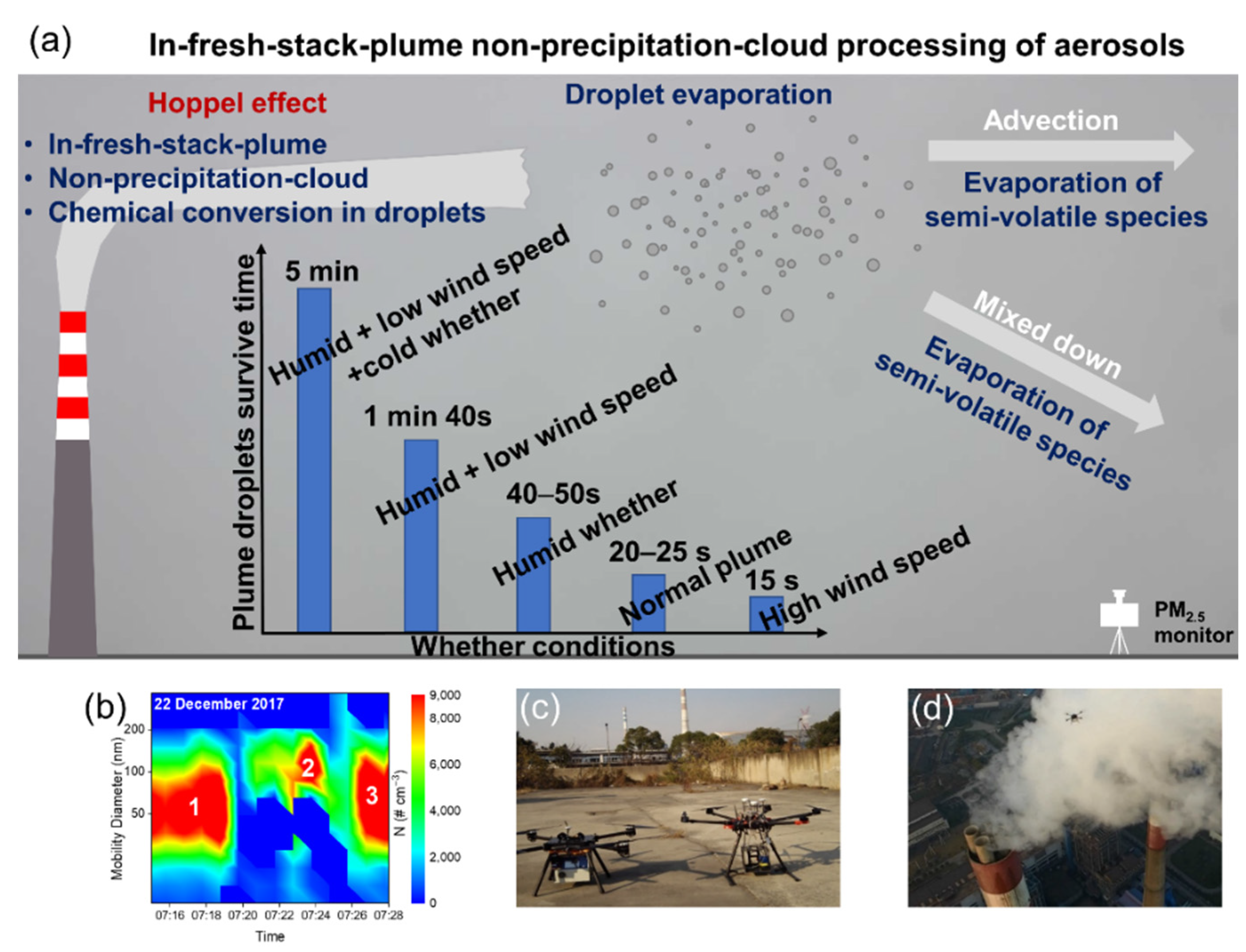

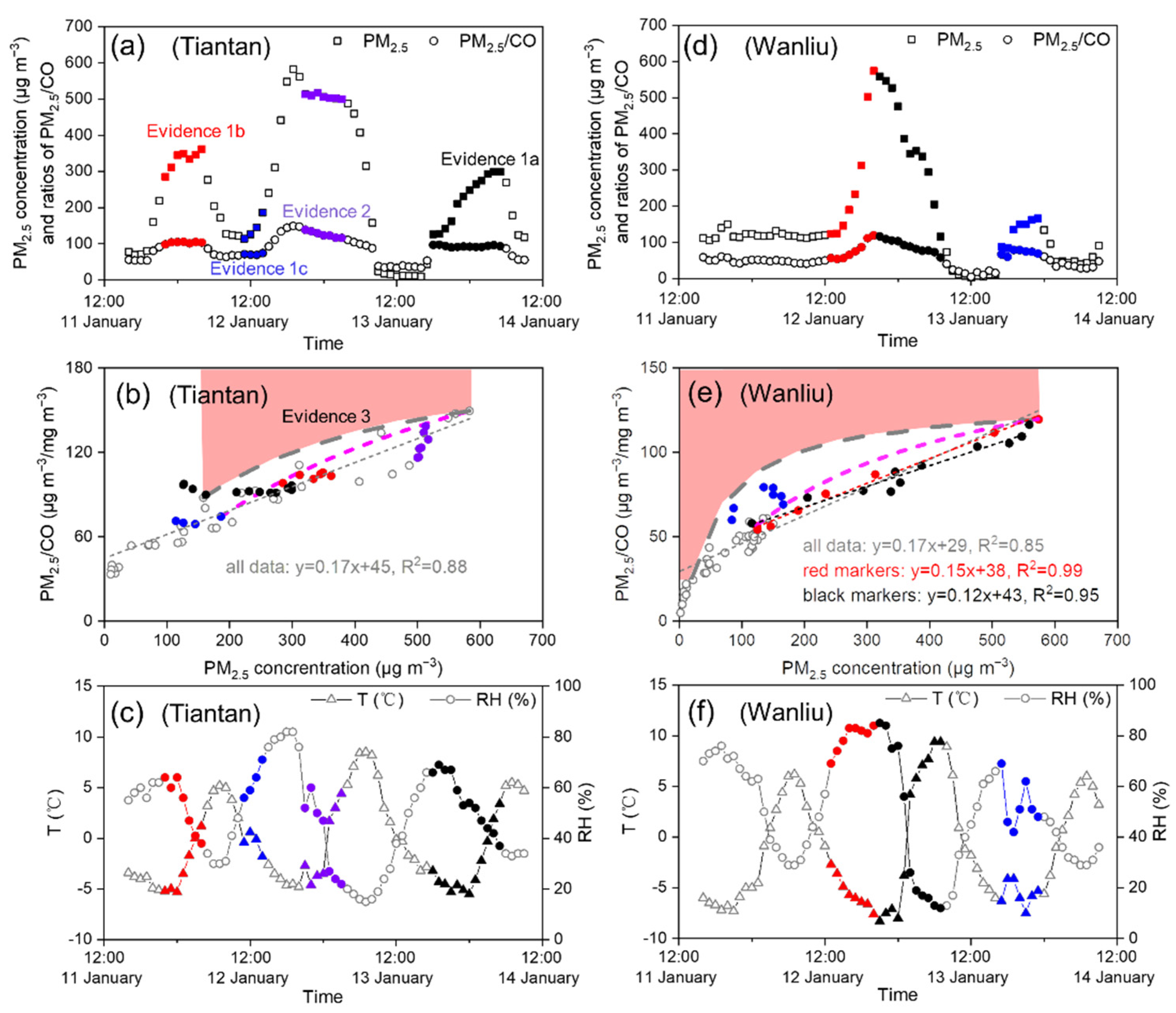
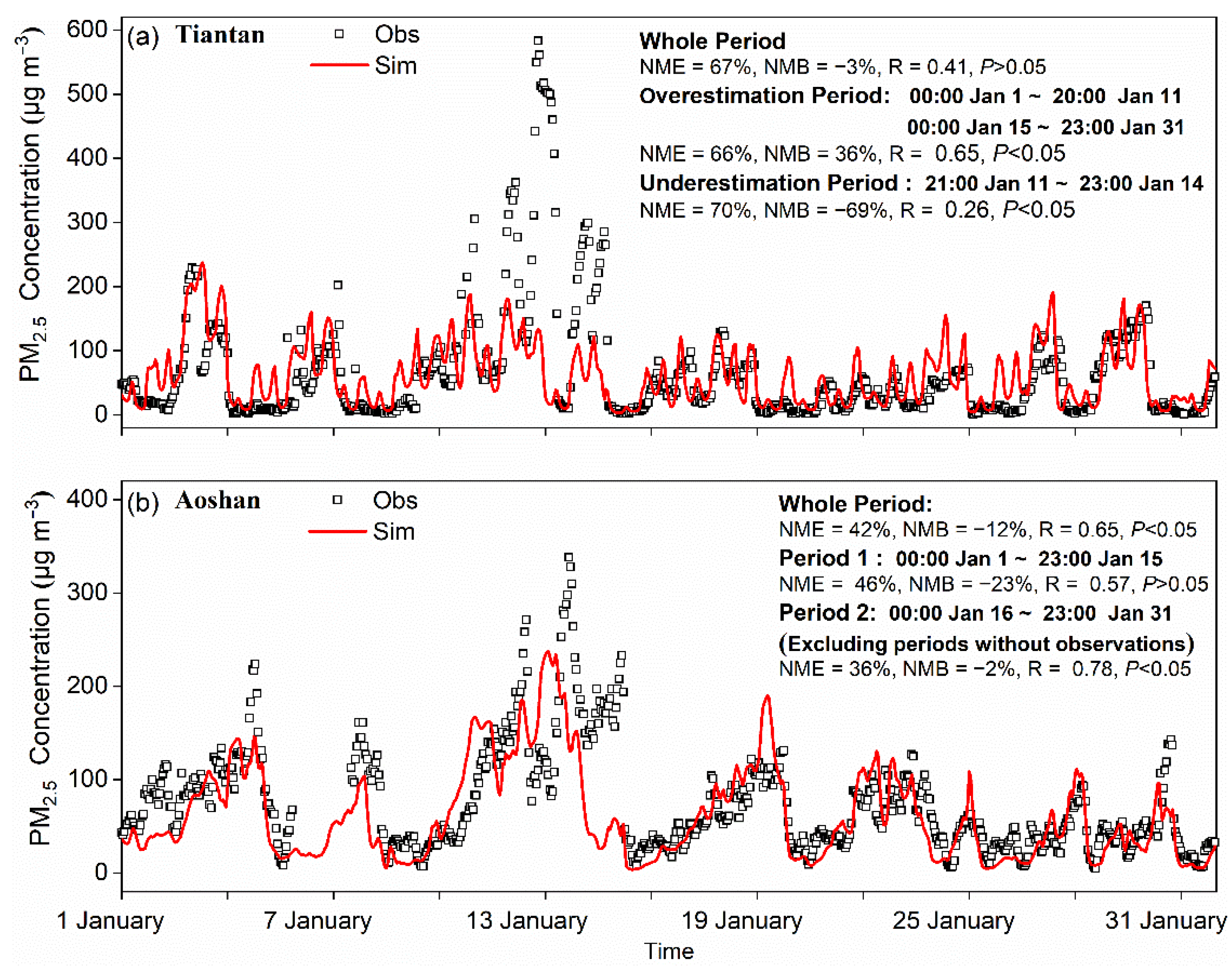
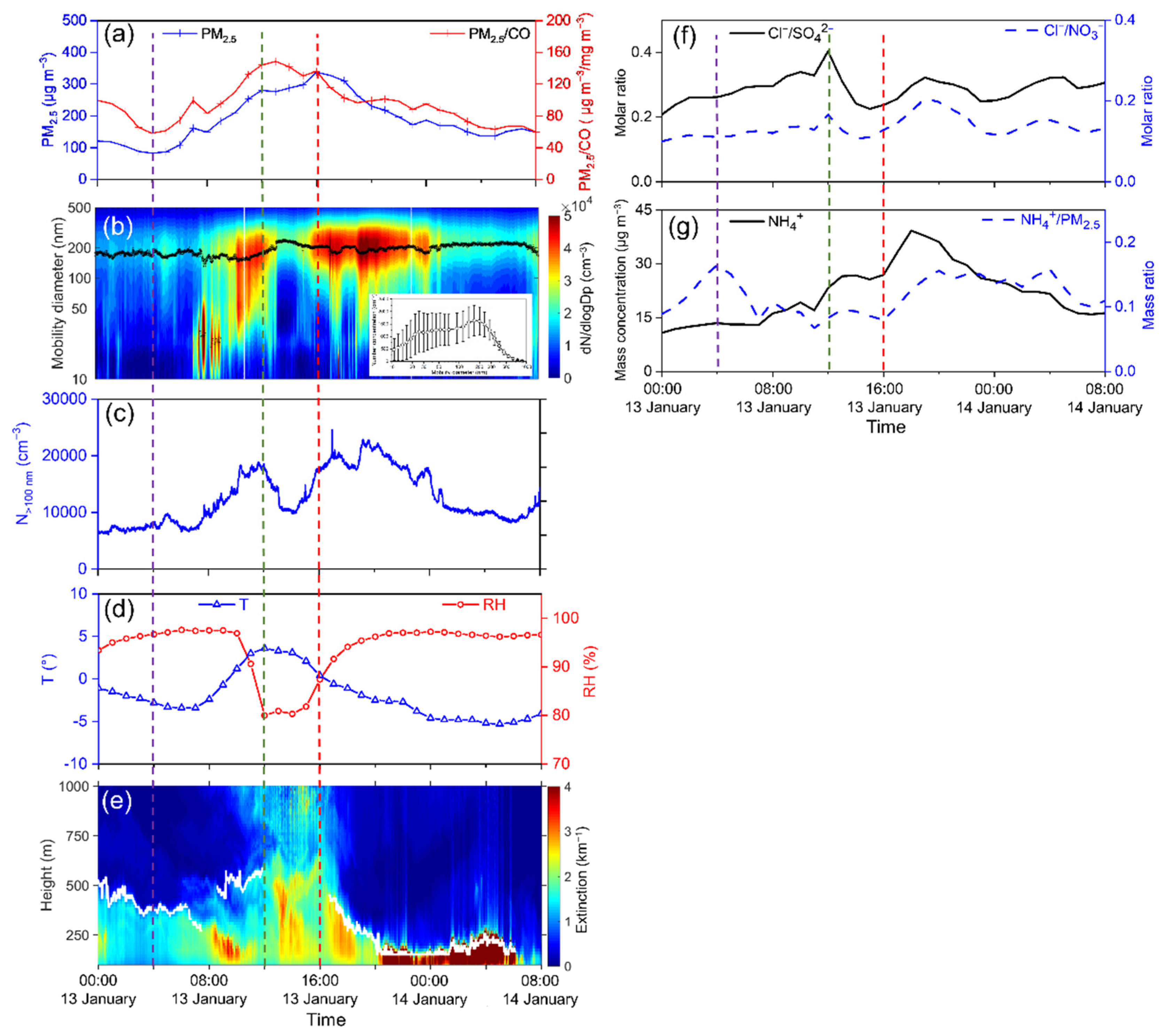
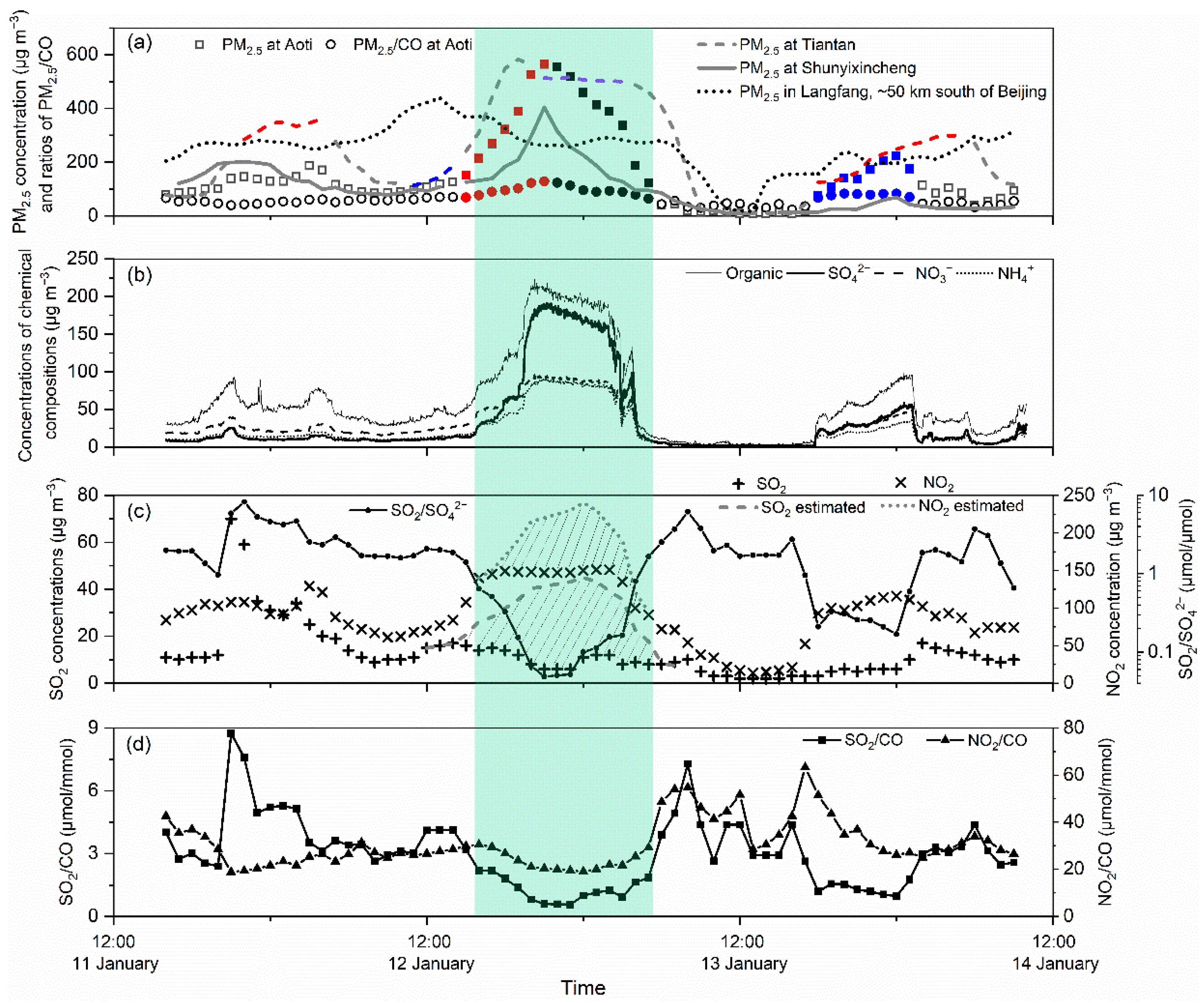
Publisher’s Note: MDPI stays neutral with regard to jurisdictional claims in published maps and institutional affiliations. |
© 2022 by the authors. Licensee MDPI, Basel, Switzerland. This article is an open access article distributed under the terms and conditions of the Creative Commons Attribution (CC BY) license (https://creativecommons.org/licenses/by/4.0/).
Share and Cite
Shen, Y.; Meng, H.; Yao, X.; Peng, Z.; Sun, Y.; Zhang, J.; Gao, Y.; Feng, L.; Liu, X.; Gao, H. Does Ambient Secondary Conversion or the Prolonged Fast Conversion in Combustion Plumes Cause Severe PM2.5 Air Pollution in China? Atmosphere 2022, 13, 673. https://doi.org/10.3390/atmos13050673
Shen Y, Meng H, Yao X, Peng Z, Sun Y, Zhang J, Gao Y, Feng L, Liu X, Gao H. Does Ambient Secondary Conversion or the Prolonged Fast Conversion in Combustion Plumes Cause Severe PM2.5 Air Pollution in China? Atmosphere. 2022; 13(5):673. https://doi.org/10.3390/atmos13050673
Chicago/Turabian StyleShen, Yanjie, He Meng, Xiaohong Yao, Zhongren Peng, Yele Sun, Jie Zhang, Yang Gao, Limin Feng, Xiaohuan Liu, and Huiwang Gao. 2022. "Does Ambient Secondary Conversion or the Prolonged Fast Conversion in Combustion Plumes Cause Severe PM2.5 Air Pollution in China?" Atmosphere 13, no. 5: 673. https://doi.org/10.3390/atmos13050673
APA StyleShen, Y., Meng, H., Yao, X., Peng, Z., Sun, Y., Zhang, J., Gao, Y., Feng, L., Liu, X., & Gao, H. (2022). Does Ambient Secondary Conversion or the Prolonged Fast Conversion in Combustion Plumes Cause Severe PM2.5 Air Pollution in China? Atmosphere, 13(5), 673. https://doi.org/10.3390/atmos13050673






